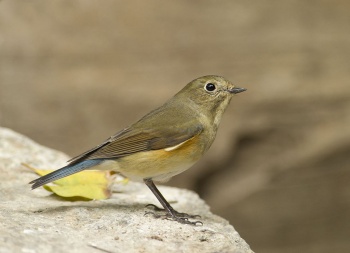Alternative names: Bluestart, Orange-flanked Bush Robin
- Tarsiger cyanurus
Luscinia cyanura
Identification
Length 13–15 cm (5-6 in), wingspan 21-24.5 cm, weight 10-16 g.
Blue tail and orangey-reddish flanks.
Adult males, and some immature males, have dark blue-grey upperparts, orangey-reddish flanks, white throat and upper breast dusky grey underparts, and a pale supercilium, white in front of the eye, pale blue behind.
Females, and also most first-winter males, are plain brown above and have a dusky breast.
Juveniles in the first few weeks after fledging are brown with pale spots, similar to a juvenile Common Redstart except with a bluish, not orange-red tail.
Distribution
Breeds in northeastern Europe and northern Asia from Finland east right across northern Russia to Kamchatka, and southeast in Asia to northern Mongolia, Manchuria in northeastern China, and northern Japan. Winters in southern China, Burma, Thailand, Laos, Sumatra and Java.
Increasingly recorded as a vagrant, or perhaps a rare winter visitor, in several western European countries, including several overwintering individuals and spring birds returning northeast. Long a major rarity in Britain, it now occurs annually (mainly on the east coast in October), with a remarkable 31 recorded in 2010.
Taxonomy
Himalayan Bluetail was formerly considered a subspecies of this species.
Formerly sometimes included in either the genera Erithacus or Luscinia4.
Subspecies
Clements recognizes two subspecies[1]:
- "T. c. cyanurus: breeds from Finland and northern Russia to east to Mongolia, northeast China, Korea, and Japan; resident in Japan (except for Hokkaido), otherwise winters to southern China, Taiwan, Indochina, Myanmar, and Thailand
- "T. c. albocoeruleus: breeds in north central China (northeastern Qinghai, northern Gansu, Shanxi, and Beijing); mostly winters at lower elevations, but some migrating south to Myanmar and northern Thailand
A subspecies T. c. pacifica is generally considered invalid3.
Habitat
Coniferous forests, typically in damp, mossy old-growth spruce Picea with scattered birch Betula; from sea level to low hills in the north of the range, in mountains in the southeast in Japan. Winters in dense, usually evergreen, forests and scrub.
Behaviour
Often seen flicking wings, and frequently quivers its tail in the same manner as redstarts.
Breeding
It nests near the ground, laying 3-5 eggs which are incubated by the female.
Vocalisation
Song: itru-churr-tre-tre-tru-trurr which is somewhat reminiscent of Common Redstart
References
- Clements, J. F., T. S. Schulenberg, M. J. Iliff, T. A. Fredericks, J. A. Gerbracht, D. Lepage, S. M. Billerman, B. L. Sullivan, and C. L. Wood. 2022. The eBird/Clements checklist of Birds of the World: v2022. Downloaded from https://www.birds.cornell.edu/clementschecklist/download/
- Gill, F, D Donsker, and P Rasmussen (Eds). 2023. IOC World Bird List (v 13.2). Doi 10.14344/IOC.ML.13.2. http://www.worldbirdnames.org/
- Avibase
- Dickinson, EC, ed. 2003. The Howard and Moore Complete Checklist of the Birds of the World. 3rd ed., with updates to October 2008 (Corrigenda 8). Princeton: Princeton Univ. Press. ISBN 978-0691117010
- Knox, A.G. et al. 2008. Taxonomic recommendations for British birds: Fifth report. Ibis, 150, 833–835
- Collins Bird Guide ISBN 0 00 219728 6
- Thread discussing the taxonomy of this species
Recommended Citation
- BirdForum Opus contributors. (2025) Red-flanked Bluetail. In: BirdForum, the forum for wild birds and birding. Retrieved 15 May 2025 from https://www.birdforum.net/opus/Red-flanked_Bluetail
External Links
GSearch checked for 2020 platform.1






